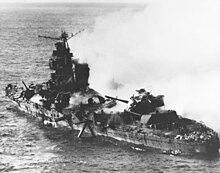Mikuma (ship, 1935)
|
The Mikuma 1939
|
||||||||||||||||||
|
||||||||||||||||||
|
||||||||||||||||||
|
||||||||||||||||||
|
||||||||||||||||||
The Mikuma ( Japanese三 隈) was a Mogami-class cruiser of the Imperial Japanese Navy . The ship was named after the Mikuma River in Ōita Prefecture .
Calls

The four cruisers of the Mogami class formed the 7th cruiser squadron. The Mikuma and her sister ship Mogami played an important role in the battle in the Sunda Strait . There the two cruisers sank the American heavy cruiser USS Houston and the Australian light cruiser HMAS Perth on March 1, 1942 .
Midway
In June, the Mogami and Mikuma were affiliated to the association that served the Midway Islands . During the retreat from the Midway Islands, the formation of the cruisers had to perform an evasive maneuver after the discovery of the American submarine USS Tambor . Due to a misjudgment by one of the Mogami officers, the Mogami rammed the Mikuma to port.
While the Mogami could only run 12 knots with the bow pushed in, the Mikuma was only damaged in one of its fuel bunkers. However, it trailed a telltale trail of oil that was discovered by an American PBY reconnaissance aircraft. It reported the two cruisers by radio as " battleships " that tried to escape damaged - 125 miles from Midway.
The battered ships were first attacked by land-based B-17 long-range bombers, then by dive bombers launched by the American carriers USS Enterprise and USS Hornet . The Mogami succeeded after several hits, serious damage of the reach of dive bombers to escape, the Mikuma however, was bombed to the wreck.
First of all, an attacking SB2U Vindicator bomber was shot down by the Mikuma's air defense during its low target approach . He fell on one of the aft towers of the cruiser and his burning fuel leaked through the ventilation system into the engine room on starboard, so that it had to be abandoned.
After further attacks, there were finally five bomb hits on the cruiser, which led to fires and secondary explosions of anti-aircraft ammunition and torpedoes that could not be brought under control. The central part of the cruiser was largely destroyed by the explosions, the main mast felled and the aircraft catapults torn from their anchorages. The exploding anti-aircraft ammunition on deck caused severe damage to the bridge structure and seriously wounded the commander , Captain Sakiyama. He died three days later on board the Suzuya , a sister ship of the Mikuma .
The heavy cruiser Mikuma sank completely burned out on June 6, 1942. 642 sailors were killed, two destroyers saved 240 men. Three days later, two other survivors were picked up by a US submarine.
wreck
No attempts have yet been made to track down the Mikuma wreck . The presumed Untergangsort of the vessel is 29 ° 20 ' N , 173 ° 30' O .
Evidence and references
Remarks
- ↑ for February 1940 according to Japanese Cruisers of the Pacific War. P. 451
Individual evidence
- ^ Paul S. Dull: A battle history of the Imperial Japanese Navy, 1941-1945. US Naval Institute Press, 2007, ISBN 1-59114-219-9 , pp. 164-166.
